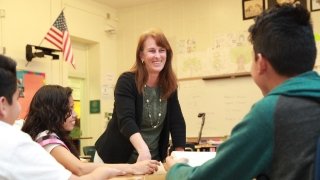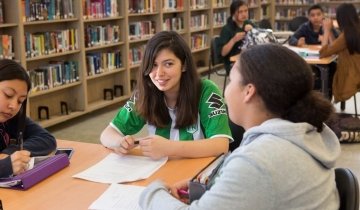When it comes to addressing a wide range of skills and abilities in your classroom, there is no one-size-fits-all solution. As a teacher, you have to tailor your lesson plan to different learning styles, student backgrounds and a variety of other factors.
If this sounds like a daunting challenge, Eugenia Mora-Flores, EdD, has some reassuring guidance for you. Mora-Flores is the chair of the Master of Arts in Teaching (MAT) program at USC Rossier.
(Prepare to make a difference in the classroom.)
As a Professor of Clinical Education, former K–12 teacher, author and consultant to K–12 schools across the country, here is her expert advice on how to educate students of varying skills and abilities in your classroom.
Use differentiation
Differentiation is the process of making education accessible for all students. It’s a personalized approach to teaching that addresses individual learning needs rather than using one strategy to address everyone.
Additionally, differentiation is a useful tool for promoting equity in the classroom. It not only accounts for different learning styles, but student backgrounds and experiences as well.
Use differentiation to accommodate visual, aural and verbal learners, gifted students and students with moderate disabilities—all while acknowledging the unique cultural perspectives of historically marginalized students.
Differentiate at every phase of the lesson plan
Differentiated instruction means using “a range of strategies to communicate the same information in a lesson,” said Mora-Flores.
Lesson plans are typically structured in phases. “In each phase of the lesson, there may be opportunities to accommodate [different] needs. [But we don’t want] teachers to think they need to create 15 different lessons.”
Here are some common phases with examples of accompanying differentiation strategies:
The introductory phase
In the introductory phase of a lesson, you may want to use visuals to recap the previous lesson, while asking a higher-level question to engage gifted learners. You can also break students into groups to discuss prior learning.
The research/Inquiry phase
In the research phase of the lesson, you can offer a variety of resources for students to learn more about a subject. By providing different modalities such as articles, podcasts, videos, models, experimentation opportunities etc., you ensure that everyone is able to connect with the topic.
The demonstration phase
Use think-alouds (i.e. ask questions and discuss how to understand the content that you’re reading) to demonstrate how to acquire comprehension skills.
The practice/application phase
As students work on their own, you can address them individually. Support them by prompting their thinking and guiding them through challenges.
Explore other instructional strategies
Differentiation is a broad term that encompasses many different instructional strategies. In order to address a wide range of skills and abilities in your classroom, explore different tactics under the umbrella of differentiation to find out what works for you and your students.
Creating peer interaction groups for students can be effective. Whether it’s partnerships, small or large groups, each has its own unique benefits. Switching partners or groups within group discussions can also help keep perspectives fresh.
For students who require support developing their academic language, teachers can use language tools such as sentence frames and key academic vocabulary words, as well as providing opportunities to talk to their neighbors or table mates to rehearse the language.
“We also have strategies that help students organize their thinking,” Mora-Flores added. “Graphic organizers [help students] figure out just how to organize the range of information that’s coming in.”
Consider intentional grouping
Intentional grouping is when teachers organize students by common interests, backgrounds, or other criteria.
For example, students who demonstrate an interest in pursuing a topic at an advanced level or perhaps students with varying academic ability, can work together to tackle a specific question from your lesson plan. Through collaboration, they use their shared interests or attributes to better engage with the material as individuals.
Take a holistic view of students’ needs
It’s important to consider a wide variety of factors that affect students’ ability to learn. Mora-Flores adds that teachers should “look beyond formal identifications of students in our classrooms to really think about students as individuals.”
Here are a few important formal (and less formal) categories of students whose needs you should plan to accommodate:
- English language learners.
- Students with special needs. (This is a broad term—make sure you identify the particular need and plan accordingly.)
- Gifted and advanced learners.
- Students who prefer collaborative spaces.
- Independent workers.
- Home and family backgrounds.
Addressing diversity requires thorough planning
All students bring a range of cultural and social experiences and assets to build upon at school. To ensure that your classroom is equitable for everyone, first reflect on class subject matter as a whole.
For example, if you’re tasked with teaching American history, compare the range of diversity in the United States versus the European perspective of your textbook. Does it represent the experiences and history of the students in your class?
Then, once you’re organizing your lesson plan, determine how to engage students about equity and diversity. Allow them to have critical dialogue with each other so that they can understand different perspectives.
Collaboration enhances learning for everyone
Collaboration is a key tool to addressing a wide range of skills and abilities in the classroom. “The opportunity to hear something from a different perspective helps us understand the bigger picture of what we’re studying,” said Mora-Flores.
Additionally, collaboration can have the following benefits for students with varying needs:
- Self-reflection. Hearing about others’ experiences can motivate them to refine their point of view.
- Exchange of language. Hearing peers articulate their ideas can help students develop their academic language, and ability to share their own thoughts with a range of audiences.
- Students feel valued. Collaboration makes students feel like they belong to a community of learners.
- Increased empathy. Understanding different experiences helps students empathize with their peers.
A Master of Arts in Teaching empowers you to support more students
While there are other paths to earning your teaching credential, aspiring teachers can build an enhanced set of skills at an accelerated pace through a master of arts in teaching program.
For example, USC Rossier’s MAT program prepares you to meet teaching profession standards, as well as standards for supplemental certifications. You acquire the knowledge to teach in a general education classroom, and can choose to pursue an Education Specialist Credential, California Bilingual Authorization for Spanish, or Gifted Education Certificate.
With your enhanced preparation, you’ll be equipped to address more student needs in your classroom once you start teaching.
Ready to help all students succeed?





